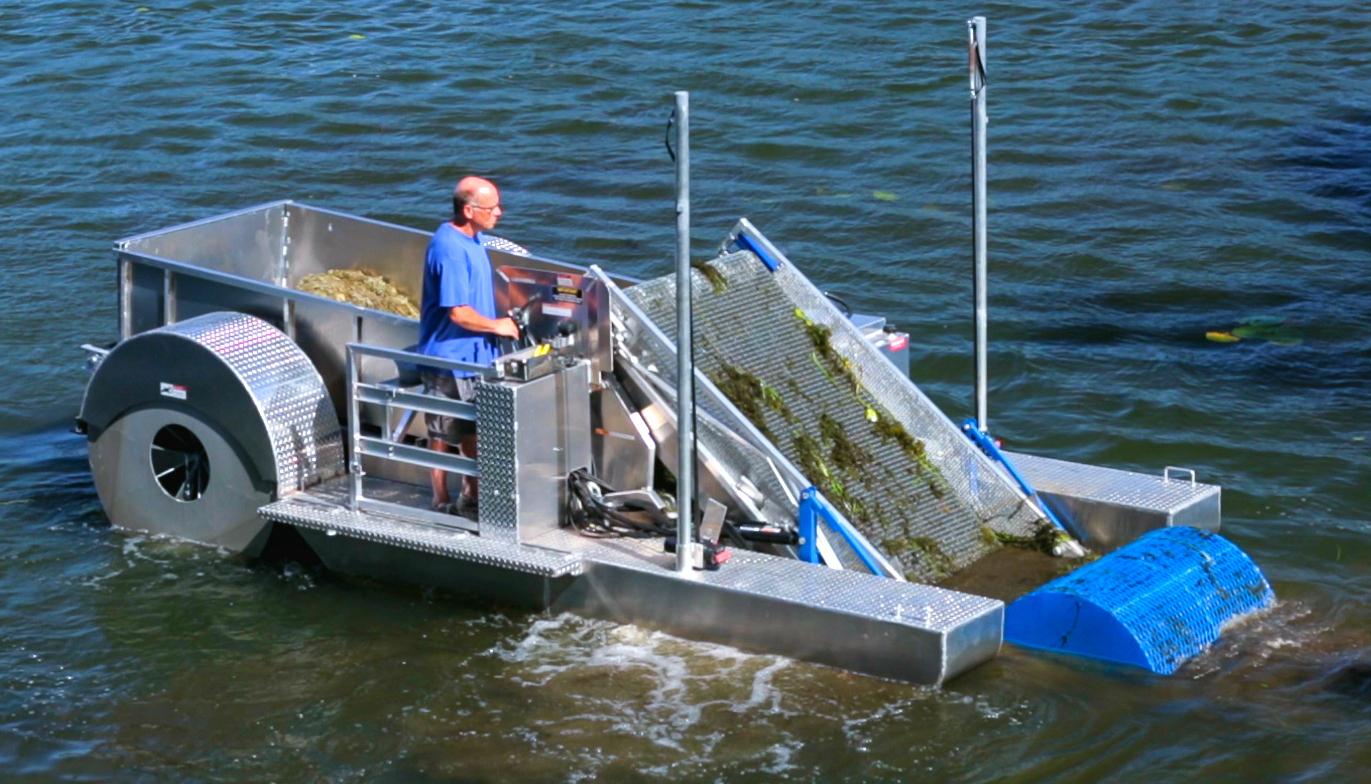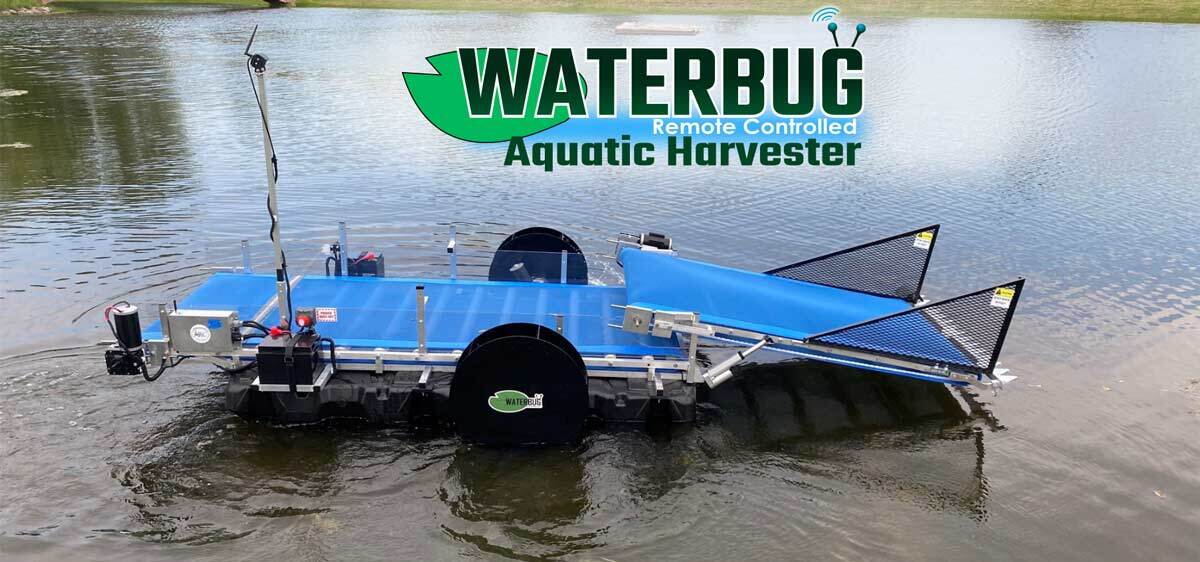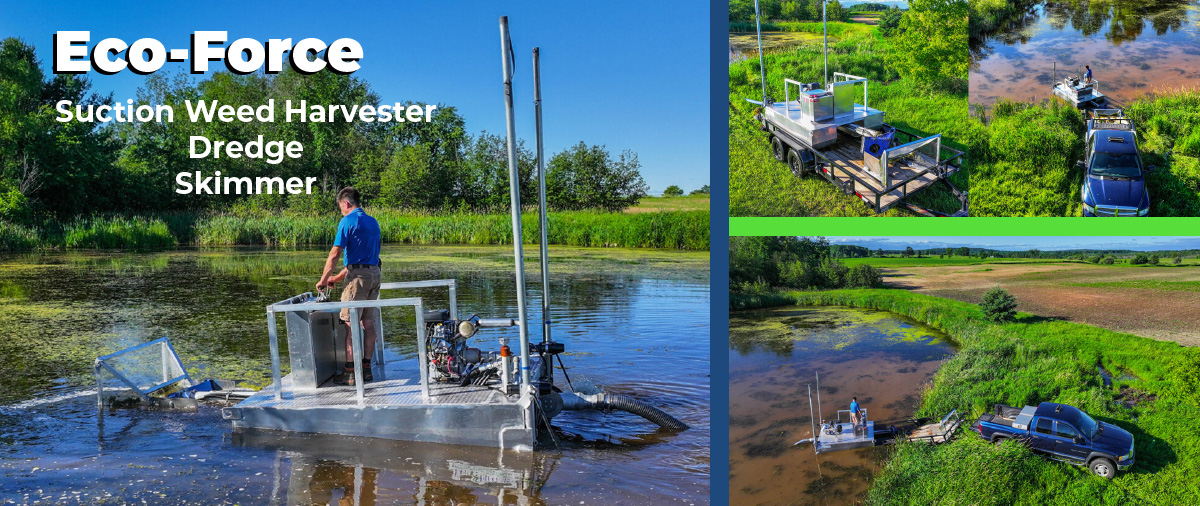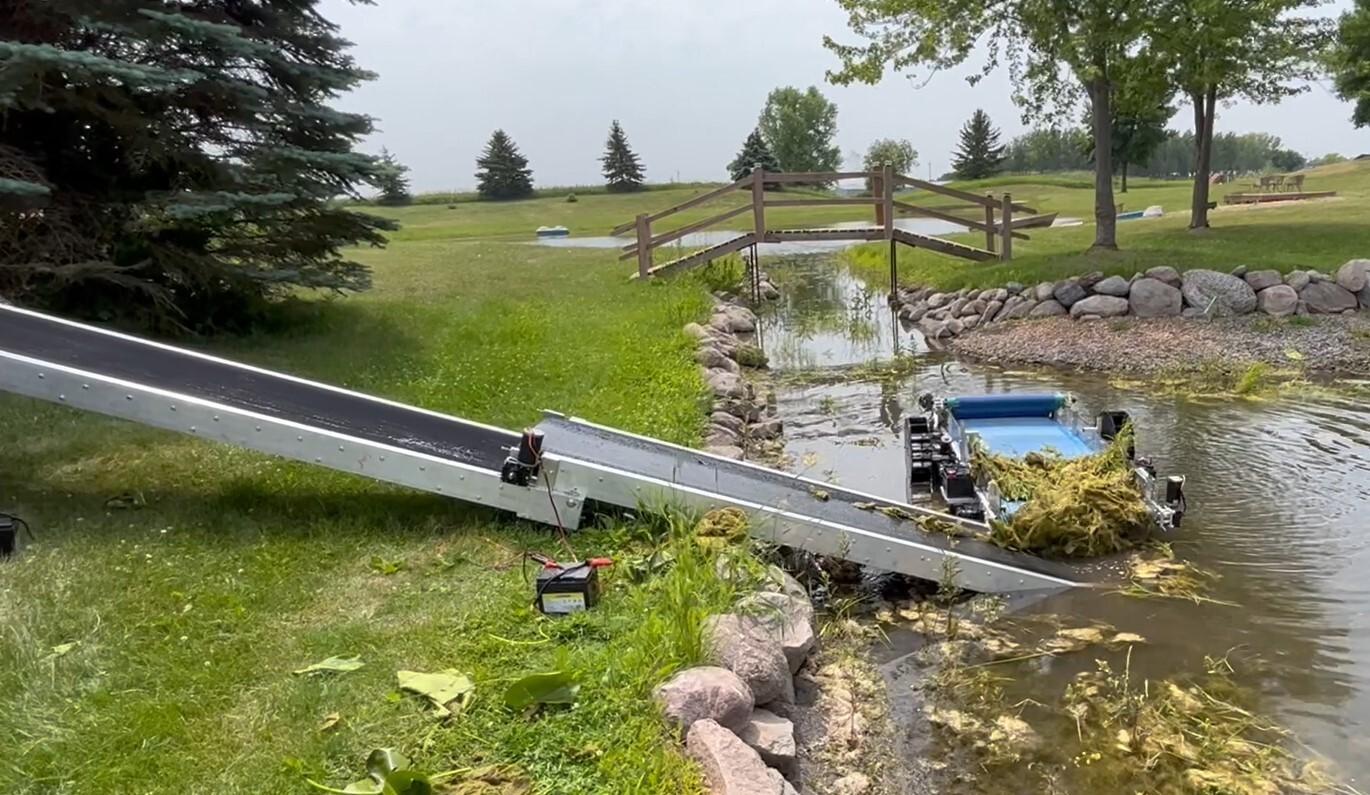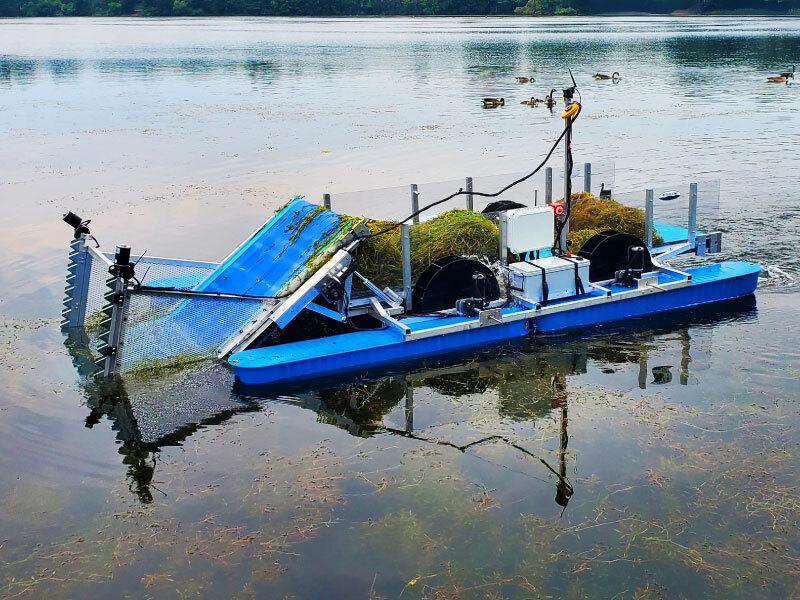Aquatic Harvesters
Aquatic Harvesters
Weeders Digest is the go-to professional for your commercial harvesting needs for your lake or pond. With our expertise in outfitting lake associations, businesses, cities and homeowners, we have the experience and right information to help solve your problems in a timely and cost effective manner . Read the articles below for some valuable information.
Aquatic Lake Weed Harvester’s Origins and Purpose
Aquatic harvesters or lake weed harvesters are aquatic machines designed for water management to cut and remove submerged and emergent aquatic plants or lake weeds. This is typically referred to as aquatic weed harvesting. Lake weed harvesters are developed to help maintain inland lakes, rivers, canals, and ponds to remove excessive lake weeds that negatively impact a waterbody’s ecology.
The true origins of the harvesting industry began with a weed cutter boat built in 1903 by the Hockney Company in Silver Lake Wisconsin. Since their genesis in 1903, lake weed harvesters have evolved into pontoon sized boats for managing smaller bodies of water like ponds and channels to larger sized aquatic harvesters used to maintain much larger waterbodies like lakes and rivers.
Traditional lake weed harvesters are paddle wheel driven and employ sickle-cutter technology to efficiently cut and collect submerged and emergent weeds below the water surface. Once cut, the aquatic plants are conveyed up the intake conveyor and dumped into the storage bunk until fully loaded. Once full, the harvester offloads the collected weeds either directly onto the shore or into a transport barge for larger lakes, ensuring continuous operation and productivity.
Aquamarine in Canada and Inland Lake Harvesters, based in Burlington, Wisconsin, are pioneers in manufacturing these sickle-cutting aquatic harvesters. They offer a range of sizes to accommodate different water body sizes and weed management needs. Aquamarine's entry-level harvester, the H5-200, is priced around $90,000 and features a stainless-steel construction, a diesel engine for hydraulics and paddle wheel propulsion. Inland Lake Harvester's least expensive model is the ILH 5x4-100 "Mini," also retailing around $90,000.00, cuts a 5-foot width by 4-foot depth but only holds 100 cubic feet of harvested lake weeds.
Lake Weeder’s Digest’s Eco-Harvester is the only harvester on the market that provides dual purpose weed pulling and surface skimming. The Eco-Harvester is equally effective skimming floating weed fragments, algae blooms, duckweed, and other floating debris.
Weedoo, based in South Florida, and Dorotea from Sweden, provide smaller lake weed cutters and gatherers, ideal for ponds and hard-to-reach waters. Weedoo's TC 3000 has a fiberglass hull and deck-mounted boom cutter and front-end loader bucket system starting at $90,000. It is expensive for the application as cutting and collecting lake weeds is a two-step process making it inefficient for harvesting on lakes.
Dorotea's Truxor is an amphibious tool carrier ideally suited to reach areas and terrains that are difficult to access. The Truxor starts out at around $90,000.00 and for the price and productivity, is better suited for small ponds and drainage ditches that clog up with weeds and cause flooding vs lake applications.
In 2012, Lake Weeder’s Digest introduced the Eco-Harvester which pulls aquatic plants by the roots and skims floating debris instead of cutting lake weeds like traditional lake weed harvesters. At $102,000.00, it is priced the same as traditional harvesters, but this new technology revolutionized aquatic harvesting by eliminating the plant instead of giving it a haircut. The harvester is made from aluminum making it lighter, faster, and more maneuverable than its contemporaries enabling it to operate in shallow water around docks and lifts.
During the spring of 2021, Lake Weeder’s Digest introduced the Waterbug remote controlled harvester. At $15,399.00, this new technology lowered the barrier to entry to lake weed harvesting and made it accessible to individual lake home owners and affordable for entrepreneurial types and owner operators to get into lake weed harvesting. Since its introduction, Lake Weeder’s Digest has added a complete line of affordable and innovative remote-controlled harvesters including the WaterGator and Watershark.
New to Lake Weeder’s Digest’s fleet is the new Eco-Force which is a combination suction harvester and suction dredger designed to harvest both aquatic plants and sediment without the use of divers. Hydraulically powered to harvest and dredge down to 7’+, it is affordably priced for dual purpose suction harvesting and dredging at under $60,000.00.
Shore Transfer Conveyors:
Shore transfer conveyors work in unison with aquatic lake weed harvesters as an unloading link between land and water. Harvested lake weeds are off-loaded from the aquatic lake weed harvester onto a shore transfer conveyor that then elevates the lake weeds up into a waiting dump truck or trailer.
Most shore conveyors can be pulled by a full-size pickup truck and are designed to be positioned at the water's edge. They are designed to be positioned over a seawall, riprap, or embankment and typically powered by gas engines or AC power options.
Lake Weeder’s Digest offers a new 15.5’ long x 2’ wide conveyor that is designed to work with their remote-controlled harvesters! It can off-load directly to the shore transfer conveyor. This cleverly designed shore conveyor was designed to be stackable to extend to 30’ and 45’ lengths. It can also fit in the back of your pick-up truck or small trailer and weighs only 150 pounds.
Comparing Lake Weed Harvesting Methods: Cutting, Pulling, and Suction Harvesting
Traditional harvesters are an excellent option for harvesting lake weeds in deeper parts of the lake, with the goal of preventing lake weed infestation and keeping waterways open. Due to their size and weight, they do not do a very good job maintaining shallow areas and are difficult to maneuver around docks, piers, and boat lifts.
Cutting weeds with traditional harvesters, while efficient in certain settings, has its drawbacks. Sickle-cutting produces weed fragments that float to the surface which can be problematic for two reasons, 1) The floating weed fragments float to the surface and the wind and wave action blows them into the shoreline for lake home owners to rake and 2) Floating weed fragments from invasive plants like Curly-Leaf Pond Weed or Eurasion Milfoil can float into other parts of the lake and repopulate.
The Watebug, WaterGator, and Watershark offered by Lake Weeder’s Digest are perfectly suited to for shallow water operation around docks and boat lifts because they produce minimal fragmentation and they can float in as little as 4” of water.
Aquatic weed pullers and diver assisted suction harvesting (DASH) that eradicate the aquatic plants are not limited by cutting depth like traditional harvesters. Unlike traditional harvesters, this approach provides complete removal of the plants in water depths where lake weed growth is problematic. A weed pulling harvester such as the Eco-Harvester from Lake Weeder’s Digest will pull out the entire plant by the root and in effect, eliminating the plant from growing back! Constructed from marine grade aluminum, the Eco-Harvester is lightweight and able to maneuver in shallow water around boat lifts and docks.
DASH also removes the plant as the diver pulls the plant and places into the suction hose and then the pump discharges the plants to the shoreline or into a filtration bag. It is more labor intensive as it involves a boat operator and diver(s) but it is not as efficient as either traditional or weed pulling harvesters. The NEW Eco-Force launched by Lake Weeder’s Digest is a combination suction harvester and suction dredger that removes the plant and the sediment! It is far more efficient than DASH as it does not require divers to operate and, in most cases, is half the cost of competitor models coming in at $59,999.00!
The Eco-Harvester and Eco-Force offer significant advantages over traditional and DASH harvesters. By removing the entire plant, they prevent regrowth, reducing the frequency of harvesting needed. Additionally, they eliminate the issue of floating debris, keeping shorelines clean and reducing the risk of spreading invasive species.
In summary, while traditional cutting harvesters play a vital role in aquatic vegetation management, pulling harvesters and suction harvesters provide a more complete solution by addressing the limitations of cutting methods, particularly in shallow waters and areas close to human
Navigating Aquatic Weed Management Choices: Herbicides, Contractors, or Harvester Purchase
Deciding on the best method to control lake weeds—purchasing a harvester, hiring a contracting service, or using herbicides—is increasingly complex. Climate change is producing warmer temperatures causing drought conditions which leads to lower water levels. This recipe is the perfect storm for accelerated lake weed growth and unfortunately, extremes in climate change is only going to make it worse.
Historically, lake associations have leaned towards herbicide treatment for their perceived cost-effectiveness. However, this approach is only a temporary fix rather than a long-term solution because the herbicides may kill the lake weeds, but they sink to the bottom, decay into lake muck which uses valuable oxygen, reduces water depth. Worst of all, the muck is the nutrients fueling the following seasons weed growth. In essence, it is perpetuating the problem long-term and, in some cases, there is not an effective herbicide to kill the plant like the invasive Starry Stonewort.
Financially, herbicide treatments can be expensive and nationally, the regulatory trends are moving towards restrictions or outright bans on herbicide treatments!
Hiring a harvesting company is an eco-friendly solution provided you can find one in your area. The lake weed harvesting market is underserved regardless of where you are located and if you do find one, chances are they are already booked for the season. If you do find one, weather conditions can greatly affect schedules and therefore availability leaving you without any control to solve your problem. Conversely, owning a harvester, though initially expensive, provides long-term, eco-friendly control over weed management, allowing for immediate action as needed without recurring costs or the unpredictability of contractor availability.
While herbicides provide a quick fix, their environmental impact make them less viable long-term. Contracted services offer flexibility without investment but at an ongoing cost (if you can even find one). Investing in a lake weed harvester stands out as a better investment long-term as it is no more expensive than 1-2 years of treating your lake with herbicides. It is 100 % effective, eco-friendly, and gives you autonomy to solve your lake weed issues on your terms.
Selecting an Aquatic Harvester: Key Considerations
Choosing the best harvester involves assessing several critical factors to ensure it meets your specific needs:
- Budget: Consider not just the purchase price, but also ongoing costs such as labor, fuel, and maintenance. These expenses are integral to the total cost of ownership.
- Intended Use: Define the harvester's primary function—residential, commercial, or both. Consider the variety of water bodies it will be used in, transportation needs between locations, and whether the water body has easy access, like a boat landing. Also, determine if you need harvesting and skimming functionalities.
- Productivity: For commercial harvesting, productivity is paramount to making money. Factors affecting productivity include transport speed to and from the harvesting site. Consider whether the harvester can be operated by one person or requires a team.
- Availability: Manufacturing lead times can vary significantly. Some manufacturers build to order with lead-times between 60-90 days. Other suppliers like Lake Weeder’s Digest maintain inventory and can typically deliver within 2 weeks of order placement.
Launching a Lake Weed Harvesting Business: A Step-by-Step Guide
Any lakefront owner will tell you that upkeep involving raking and pulling weeds is laborious and time consuming. It is no surprise then to learn that many are looking to hire a contractor instead of doing the work themselves. The problem is that the lakeshore management companies are in short supply and it is a market that is grossly underserved nationally.
Regardless of where you are in the country, most any sub-contractor or lake weed harvesting company has more business than they can possibly handle! In short, the market is underserved and the barrier to entry is relatively easy to get into business.
If this sounds like the right opportunity for you, keep reading to find out how to start a lake weed harvesting business of your own.
Considering the range and depth of lake weed harvesting – from residential to commercial – the economics of starting your own lake weed harvesting business are remarkably simple. Even if a prospective client finds a harvesting company, most deal with shoddy service or can’t get a return phone call or email. Creating a successful harvesting business is almost easy if you simply answer the phone when your customer calls, return their voicemails and emails promptly, and do the work you agreed to with your client.
Sounds simple enough, right? But what else can you do to move beyond the basics?
- Define Services and Equipment Needs: Determine the types of aquatic plants to target and the corresponding equipment required, including disposal methods for harvested weeds.
- Lake weed harvesting-submersed aquatic plants.
- Lake weed harvesting-emergent aquatic plants.
- Skimming/removing floating algae/duckweeds.
- Beach clean-up.
- Disposing of harvested lake weeds.
- Form your Business Entity:
- Sole proprietorship is the easiest and least expensive type of business to start. This entity means you are the sole owner of the business but you will be personally responsible for business taxes, debts, and legal liabilities. In other words, your business and personal assets and liabilities are not separated under this business structure.
- Limited liability company (LLC) is preferred because under this structure, your personal and business assets and liabilities are separated and are protected in case of bankruptcy and/or lawsuits.
- Secure Licenses, Permits, and Insurance: Research local requirements for business operation and obtain general liability insurance to protect against potential damages.
- Establish Pricing: Develop your pricing model by considering the competition, operational costs, and desired profit margins. Flexibility in pricing can help adjust to market demands including hourly rate or by the project.
- Invest in Equipment: Decide between new or used equipment based on budget constraints and operational needs. Financing options may be necessary for significant purchases.
- Develop a Marketing Plan: Utilize word-of-mouth, social media, and local advertising to reach potential clients. Emphasize the unique benefits of your service, such as eco-friendly harvesting methods.


